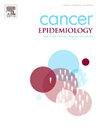2004-2019年伊朗北部戈列斯坦早发性乳腺癌流行病学:不同居住地和民族地区的差异
IF 2.3
3区 医学
Q3 ONCOLOGY
引用次数: 0
摘要
早发性乳腺癌(EOBC)在45岁以下妇女中被诊断出来,是世界范围内的一个重大健康问题。了解EOBC的流行病学对于制定有效的预防和检测方案至关重要。我们的目的是研究2004年至2019年伊朗北部Golestan的EOBC发病率和时间趋势,跨越民族地区(土库曼人与非土库曼人)和居住地(城市与农村)。方法EOBC发病率数据来自Golestan基于人群的癌症登记处(GPCR)。计算并报告每10万人年的年龄标准化发病率(ASR)。通过计算估计年百分比变化(EAPC)来研究EOBC发病率的时间趋势。结果2004-2019年,GPCR共登记了1809例EOBC新发病例,ASR为14.02 / 10万,城市ASR为16.63 / 10万,高于农村(10.94 / 10万)。非土库曼地区的EOBC发病率(16.50)明显高于土库曼地区(10.53)。我们的研究结果表明,EOBC在Golestan的发病率有显著增加的趋势(EAPC = 3.00; 95 %CI: 0.07-6.00)。值得注意的是,与城市地区(EAPC = 1.88)相比,农村地区的EAPC上升幅度更大(EAPC = 4.82),这在土库曼和非土库曼地区都具有统计学意义。结论土库曼斯坦eobc患病率高于全球平均水平,城市和非土库曼人群eobc患病率较高。我们的研究结果还表明,EOBC的发病率有显著增加的趋势,其中农村居民的变化更大。这些发现突出表明,该地区需要有针对性的干预措施和早期发现战略。本文章由计算机程序翻译,如有差异,请以英文原文为准。
Epidemiology of early-onset breast cancer in Golestan, North of Iran, 2004–2019: Disparities across residential place and ethnic region
Introduction
Early-onset breast cancer (EOBC), diagnosed in women under 45 years, is a significant health issue worldwide. Understanding the epidemiology of EOBC is crucial for developing effective prevention and detection programs. We aimed to examine EOBC incidence and temporal trends in Golestan, North of Iran, from 2004 to 2019, across ethnic regions (Turkmens vs. non-Turkmens) and place of residence (urban vs. rural).
Methods
Data on the incidence of EOBC were obtained from the Golestan Population-based Cancer Registry (GPCR). Age-standardized incidence rate (ASR) was calculated and reported per 100,000 person-years. Temporal trends in the incidence of EOBC were investigated by calculating estimated annual percent changes (EAPC).
Results
Overall, 1809 new cases of EOBC were registered by GPCR during 2004–2019, with an ASR of 14.02 per 100,000, and higher rates in urban (ASR = 16.63) compared to rural areas (10.94). The non-Turkmens region (16.50) had significantly higher incidence rates of EOBC than the Turkmens region (10.53). Our findings suggested a significant increasing trend in the incidence of EOBC in Golestan (EAPC = 3.00; 95 %CI: 0.07–6.00). Notably, rural areas experienced a steeper rise (EAPC = 4.82) compared to urban areas (EAPC = 1.88), which was statistically significant in both Turkmens and non-Turkmens regions.
Conclusion
EOBC rates in Golestan were above the global average, with higher rates in urban and non-Turkmens populations. Our findings also suggested significant increasing trends in the incidence of EOBC, with greater changes in rural residents. These findings highlight the need for targeted interventions and early detection strategies in the region.
求助全文
通过发布文献求助,成功后即可免费获取论文全文。
去求助
来源期刊

Cancer Epidemiology
医学-肿瘤学
CiteScore
4.50
自引率
3.80%
发文量
200
审稿时长
39 days
期刊介绍:
Cancer Epidemiology is dedicated to increasing understanding about cancer causes, prevention and control. The scope of the journal embraces all aspects of cancer epidemiology including:
• Descriptive epidemiology
• Studies of risk factors for disease initiation, development and prognosis
• Screening and early detection
• Prevention and control
• Methodological issues
The journal publishes original research articles (full length and short reports), systematic reviews and meta-analyses, editorials, commentaries and letters to the editor commenting on previously published research.
 求助内容:
求助内容: 应助结果提醒方式:
应助结果提醒方式:


